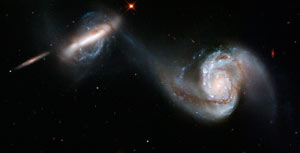
Handy Links
SLAC News Center
SLAC Today
- Subscribe
- Archives: Feb 2006-May 20, 2011
- Archives: May 23, 2011 and later
- Submit Feedback or Story Ideas
- About SLAC Today
SLAC News
Lab News
- Interactions
- Lightsources.org
- ILC NewsLine
- Int'l Science Grid This Week
- Fermilab Today
- Berkeley Lab News
- @brookhaven TODAY
- DOE Pulse
- CERN Courier
- DESY inForm
- US / LHC
SLAC Links
- Emergency
- Safety
- Policy Repository
- Site Entry Form

- Site Maps
- M & O Review
- Computing Status & Calendar
- SLAC Colloquium
- SLACspeak
- SLACspace
- SLAC Logo
- Café Menu
- Flea Market
- Web E-mail
- Marguerite Shuttle
- Discount Commuter Passes
-
Award Reporting Form
- SPIRES
- SciDoc
- Activity Groups
- Library
Stanford
Around the Bay
Mergers Most Likely Fuel for Active Galaxies
The first solid evidence for how the center of some galaxies come to shine brightly while others barely flicker has been uncovered by researchers at the Kavli Institute for Particle Astrophysics and Cosmology and several other institutions around the world. This work offers new insight into one of the most extreme environments in the universe—the tumultuous region around black holes, where gas and dust churn mightily as they slowly spiral inward.
At the center of nearly all galaxies lurks a black hole, a heavy behemoth that gobbles nearby gas and dust, drawing it in with its strong gravitational pull. While the cores of some galaxies blaze with the light given off by the black hole's hearty meal, others emit only a pale gleam as the black hole pulls in only a meager snack. Astrophysicists call the galaxy centers awash with the light of gravitationally trapped matter "active" galaxies.
"Until recently, why some galaxies are active while others are not was still a mystery," said KIPAC Astrophysicist Marco Ajello, a co-author on the recent study. Some mechanism, he continued, ensures that some have plenty of matter to feast on while others must subsist on very little.
For quite some time, Ajello said, scientists have thought that active galaxies might form when two galaxies become gravitationally intertwined and spiral into one another. As the gravity tugs the galaxies closer and closer together, they begin to merge. This brings a significant amount of matter near the black hole at the center of each galaxy, making them quite active. Eventually the galaxies will merge so completely that only one large black hole remains, and this rotund black hole will continue gobbling up the gas and dust around it, a blaze of light at the center of the merged galaxies.
"People have believed this is how it works for quite some time, but there was no proof," Ajello said.
Now, Ajello, working with scientists at institutions around the world, has uncovered the first solid evidence that this is indeed the case.
By studying the distribution of 199 nearby active galaxies in X-ray light and merging this knowledge with theoretical predictions, the researchers found that active galaxies "switch on" as they merge with other galaxies, making gas more readily available to the black holes.
The observations suggest that many of the active galaxies closest to Earth formed when pairs of galaxies of similar mass and size spiraled into each other sometime in the past 700 million years. These merged galaxies shone brightly for several hundred million years as the black holes at their centers gorged on nearby gas. Today black holes 100 to 1000 million times the mass of the Sun lurk at their cores, where they shine with moderately low brightness as they snack on the sparse gas and dust that remains in their galactic centers.
This work, which was undertaken using data from NASA's Swift satellite, will be followed by further observations using the next generation of X-ray telescopes, including eROSITA, which is currently under construction at the Max Planck Institute for Extraterrestrial Physics.
"This work reveals that the active galaxies we studied—the ones that live in our backyard—appear to be born in a merging event," Ajello said. "There's still much for us to learn about black holes and their environment. There's a lot we don't know about this region—one of the most extreme places in the universe."
This work was published in The Astrophysical Journal and was carried out by N. Cappelluti of the Max Planck Institute for Extraterrestrial Physics in Garching, Germany; M. Ajello of SLAC National Accelerator Laboratory and KIPAC; D. Burlon of the Max Planck Institute for Extraterrestrial Physics; M. Krumpe of the University of California-San Diego's Center for Astrophysics and Space Sciences; T. Miyaji of the Institute of Astronomy at the National Autonomous University of Mexico; S. Bonoli of the Max Planck Institute for Physics in Garching, Germany; and J. Greiner of the Max Planck Institute for Extraterrestrial Physics. More information about this work can be found in the Max Planck Institute press release "Massive Black Holes 'Switch on' Due to Galaxy Collision."
—Kelen Tuttle
SLAC Today, June 15, 2010
